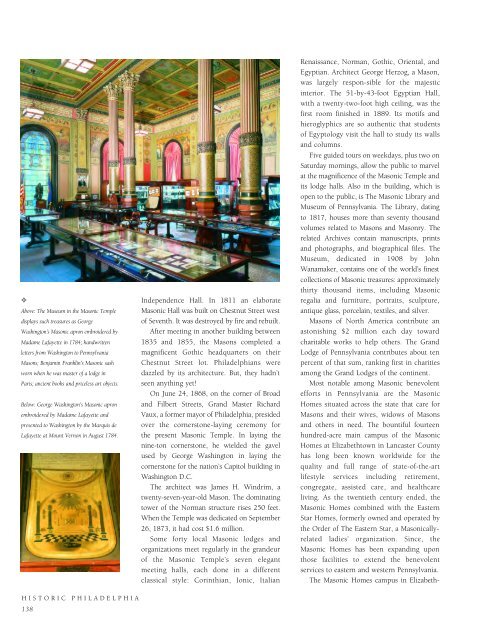Historic Philadelphia
An illustrated history of the city of Philadelphia, paired with the histories of companies, families and organizations that make the region great.
An illustrated history of the city of Philadelphia, paired with the histories of companies, families and organizations that make the region great.
You also want an ePaper? Increase the reach of your titles
YUMPU automatically turns print PDFs into web optimized ePapers that Google loves.
✧<br />
Above: The Museum in the Masonic Temple<br />
displays such treasures as George<br />
Washington’s Masonic apron embroidered by<br />
Madame Lafayette in 1784; handwritten<br />
letters from Washington to Pennsylvania<br />
Masons; Benjamin Franklin’s Masonic sash<br />
worn when he was master of a lodge in<br />
Paris; ancient books and priceless art objects.<br />
Below: George Washington’s Masonic apron<br />
embroidered by Madame Lafayette and<br />
presented to Washington by the Marquis de<br />
Lafayette at Mount Vernon in August 1784.<br />
Independence Hall. In 1811 an elaborate<br />
Masonic Hall was built on Chestnut Street west<br />
of Seventh. It was destroyed by fire and rebuilt.<br />
After meeting in another building between<br />
1835 and 1855, the Masons completed a<br />
magnificent Gothic headquarters on their<br />
Chestnut Street lot. <strong>Philadelphia</strong>ns were<br />
dazzled by its architecture. But, they hadn’t<br />
seen anything yet!<br />
On June 24, 1868, on the corner of Broad<br />
and Filbert Streets, Grand Master Richard<br />
Vaux, a former mayor of <strong>Philadelphia</strong>, presided<br />
over the cornerstone-laying ceremony for<br />
the present Masonic Temple. In laying the<br />
nine-ton cornerstone, he wielded the gavel<br />
used by George Washington in laying the<br />
cornerstone for the nation’s Capitol building in<br />
Washington D.C.<br />
The architect was James H. Windrim, a<br />
twenty-seven-year-old Mason. The dominating<br />
tower of the Norman structure rises 250 feet.<br />
When the Temple was dedicated on September<br />
26, 1873, it had cost $1.6 million.<br />
Some forty local Masonic lodges and<br />
organizations meet regularly in the grandeur<br />
of the Masonic Temple’s seven elegant<br />
meeting halls, each done in a different<br />
classical style: Corinthian, Ionic, Italian<br />
Renaissance, Norman, Gothic, Oriental, and<br />
Egyptian. Architect George Herzog, a Mason,<br />
was largely respon-sible for the majestic<br />
interior. The 51-by-43-foot Egyptian Hall,<br />
with a twenty-two-foot high ceiling, was the<br />
first room finished in 1889. Its motifs and<br />
hieroglyphics are so authentic that students<br />
of Egyptology visit the hall to study its walls<br />
and columns.<br />
Five guided tours on weekdays, plus two on<br />
Saturday mornings, allow the public to marvel<br />
at the magnificence of the Masonic Temple and<br />
its lodge halls. Also in the building, which is<br />
open to the public, is The Masonic Library and<br />
Museum of Pennsylvania. The Library, dating<br />
to 1817, houses more than seventy thousand<br />
volumes related to Masons and Masonry. The<br />
related Archives contain manuscripts, prints<br />
and photographs, and biographical files. The<br />
Museum, dedicated in 1908 by John<br />
Wanamaker, contains one of the world’s finest<br />
collections of Masonic treasures: approximately<br />
thirty thousand items, including Masonic<br />
regalia and furniture, portraits, sculpture,<br />
antique glass, porcelain, textiles, and silver.<br />
Masons of North America contribute an<br />
astonishing $2 million each day toward<br />
charitable works to help others. The Grand<br />
Lodge of Pennsylvania contributes about ten<br />
percent of that sum, ranking first in charities<br />
among the Grand Lodges of the continent.<br />
Most notable among Masonic benevolent<br />
efforts in Pennsylvania are the Masonic<br />
Homes situated across the state that care for<br />
Masons and their wives, widows of Masons<br />
and others in need. The bountiful fourteen<br />
hundred-acre main campus of the Masonic<br />
Homes at Elizabethtown in Lancaster County<br />
has long been known worldwide for the<br />
quality and full range of state-of-the-art<br />
lifestyle services including retirement,<br />
congregate, assisted care, and healthcare<br />
living. As the twentieth century ended, the<br />
Masonic Homes combined with the Eastern<br />
Star Homes, formerly owned and operated by<br />
the Order of The Eastern Star, a Masonicallyrelated<br />
ladies’ organization. Since, the<br />
Masonic Homes has been expanding upon<br />
those facilities to extend the benevolent<br />
services to eastern and western Pennsylvania.<br />
The Masonic Homes campus in Elizabeth-<br />
HISTORIC PHILADELPHIA<br />
138
















